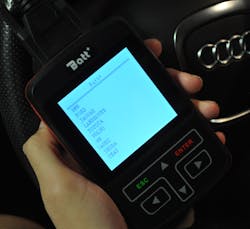One of the most frustrating things a technician comes across when diagnosing a vehicle are intermittent issues. When the issues are on an electrical system it becomes even more difficult to determine the root cause.
We’ll cover some common issues that technicians face when it comes to working on electrical systems.
Issue 1: Intermittent shorted or open circuits
Intermittent short circuits usually manifest themselves by blowing a fuse. This can be beneficial as it gives you a starting point for your diagnosis. Obtaining both the power distribution and wiring diagrams will give you details of components and other possible areas of concern. Additional valuable pieces of information are TSBs and common fixes that have been compiled by repair information sources such as AllData, Mitchell 1 or Identifix.
If there are no known common issues it may be more difficult to locate the root cause of the problem. Some possible sources of intermittent failures are connections with high resistance or loose connecting pins that cause the fuse to heat up and melt. Close inspection of connectors to see if there are signs of overheating such as discoloration of either the pins or the plastic housing is useful. In order to provide a quality repair it will be necessary to replace the connector pins and the plastic housings on both sides of the connection.
Other causes of intermittent shorts are components themselves. In this case it may be helpful to measure the resistance within the component using a DMM. Another very effective test is to use an ammeter or other testers, such as the Cal Van Amp Hound or the ESI Fuse Buddy, to measure the current the circuit is actually consuming. If the component is operated with a relay it will be necessary to activate the relay using either a relay activation tool, a Power Probe, or with bi-directional commands using your scan tool.
The source of intermittent issues with either open or shorted wiring may be difficult to locate. In addition to TSBs, other tried and true methods to find them are to physically move wiring harnesses and connections to recreate the problem. It may be helpful to place the vehicle in gear with the brakes applied while lightly accelerating. By doing this the engine, transmission, exhaust and attached components move and may pull on connections or wiring to recreate the issue. This may need to be done in forward and reverse to find the cause of the short or open circuit.
Using short/open circuit detection tools can be very valuable in determining the root cause of these problems. These tools work be transmitting a signal down the wire while using a receiver to determine where the signal changes or disappears.
Issue 2: Multiple failures of a part after initial replacement
Another annoying situation occurs when a vehicle returns for the same failure, after an initial repair. Common examples range from a simple light bulb replacement to repetitive failures of an alternator or fuel pump.
In many cases a technician will install an incorrect part resulting in a repeat failure. For instance, we have seen an incorrect bulb installed in a taillight when a technician replaced the bulb with the same part number rather than looking up the application to see if it the correct part was originally installed. In those cases a small mistake can perpetuate repetitive failures.
The same thing can occur with any electrical part such as an alternator. You should not take any shortcuts during a “warranty repair” whether it is looking up the part number or in the diagnosis. You should always start your diagnostic process from the beginning without assuming anything, especially relying on results of a test that was performed during the original repair.
Charging systems on many newer vehicles use the PCM to set the proper charge rate by assessing demand on the system. Adjusting the charge rate by need maximizes battery life and improves fuel economy by reducing engine load. Because of this it may be necessary to use your scan tool or a battery reset tool such as the BATT+ from Can Do International to perform a relearn when replacing a battery or alternator.
Failing to perform a relearn when replacing a battery or alternator may cause the system to overcharge and reduce battery or alternator life.
When any part fails, especially higher amperage parts like fans, fuel pumps or alternators, you should check to make sure there is no excessive resistance in the circuit by performing a voltage drop test.
A voltage drop will determine how much voltage is available to operate the component. If there is resistance in a circuit, it reduces available voltage and will manifest itself by having a dimmer bulb, slower starter or fuel pump, or less output from an alternator.
In order to perform a voltage drop the circuit needs to be “on” with current flowing. Reading voltage with a DMM and reading the voltage at any point will provide you with source voltage, but not necessarily give you an idea of how much resistance is in a circuit. Using a DMM to read resistance (ohms) is helpful for determining how much resistance may be in a component, but not always provide you with dependable information on wiring or connections. Simplify put, an ohmmeter sends a small amount of voltage through one end of a circuit and determines how much the voltage changes (drops) at the other end and calculates the results in ohms. With higher amp circuits and large gauge wires a more reliable test is a voltage drop.
One of the most efficient ways to perform a voltage drop is to use a Power Probe III or Power Probe IV, as they have a built-in capacity to read how much voltage drop is occurring in a circuit.
Another reliable way is to use your DMM. Let’s use a headlamp circuit as an example; start by turning the headlamps on. Next, set your DMM to a 20V scale and place the black lead of the meter at the positive battery terminal. Next, place your red lead at the positive terminal of the headlamp. The voltage reading should be as low as possible, but should be 0.2V or less. Repeat the process on the ground side by placing the black lead at the battery negative terminal and the red lead at the headlamp negative terminal. The result of this should also be less than 0.2V.
By reading the voltage in this manner you are able to determine the amount of “drop” that is occurring through the circuit. For example, if your source voltage (battery) is 12.5V and you read 1.0V on the positive side of the circuit and 1.5V on the negative side, you actual voltage drop is 2.5V, lowering your source voltage to 11.0V. In order to determine where the actual resistance issue is occurring, work backwards from the headlamp connections to the battery and perform the voltage drop test along the way paying close attention to connections, splices or grounds. When your reading goes back under 0.2V you have located the area of high resistance. It is important to remember to perform this test with the circuit activated.
Following complete diagnostic test procedures with every repair is necessary to perform quality service, but taking extra care on warranty issues can assure it will not be another comeback.



